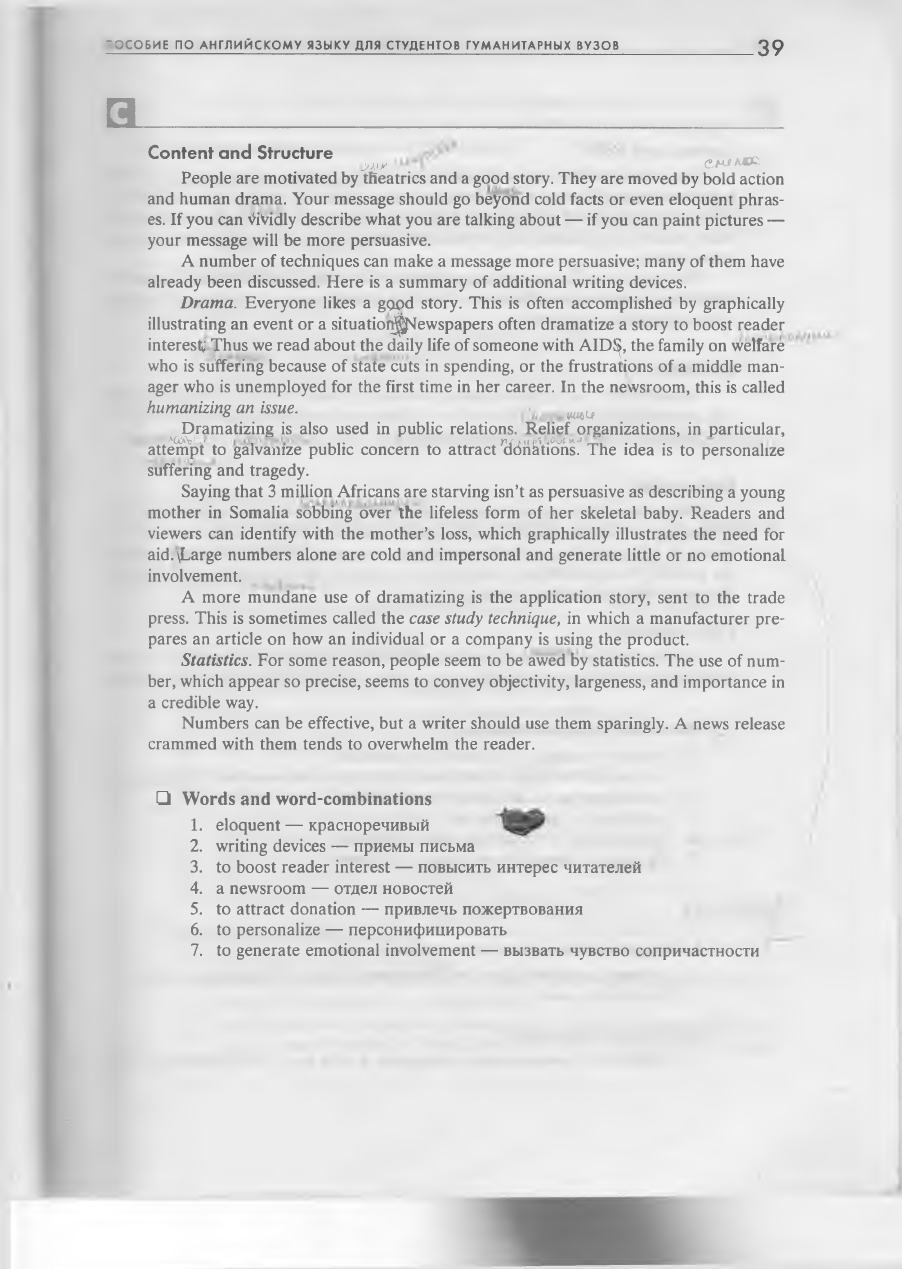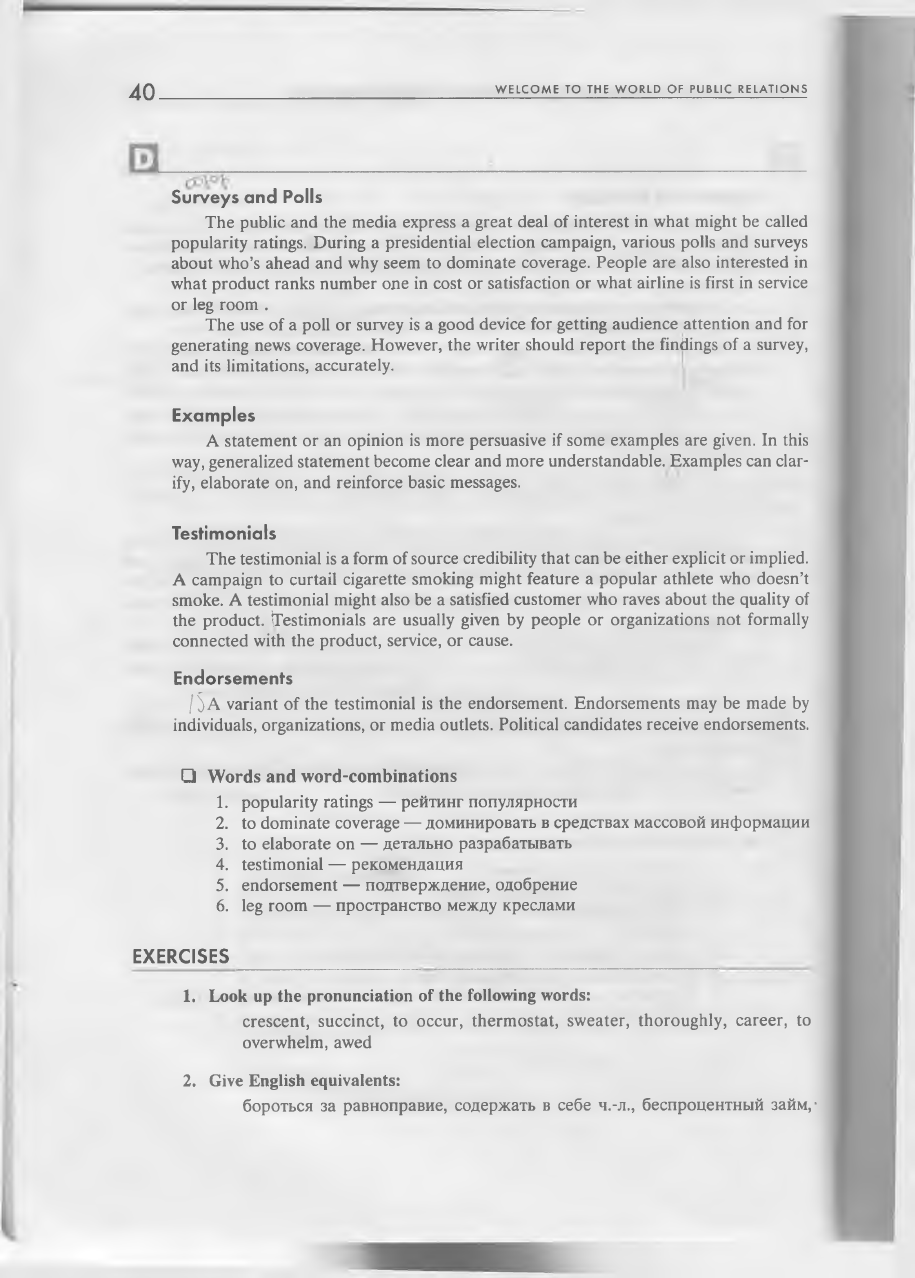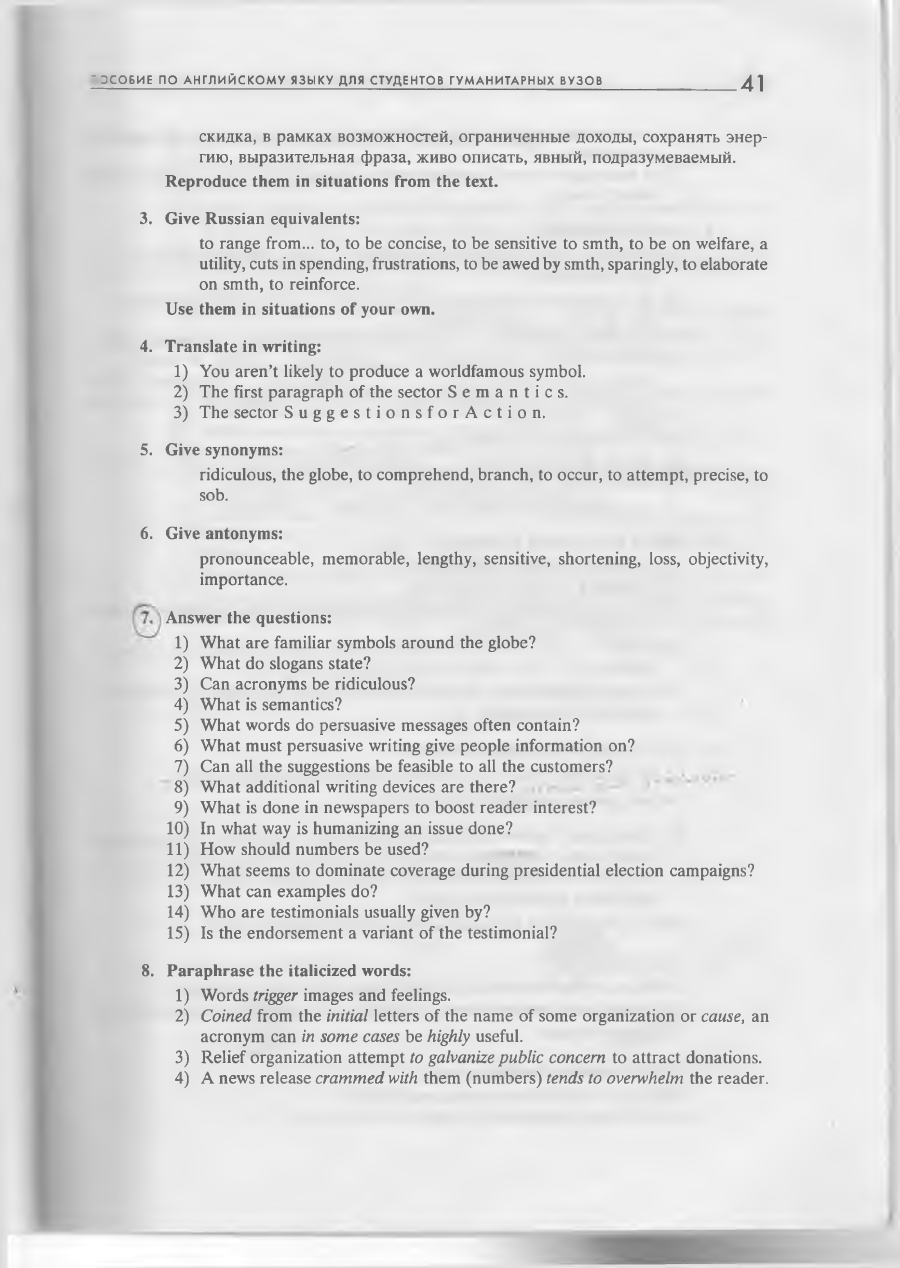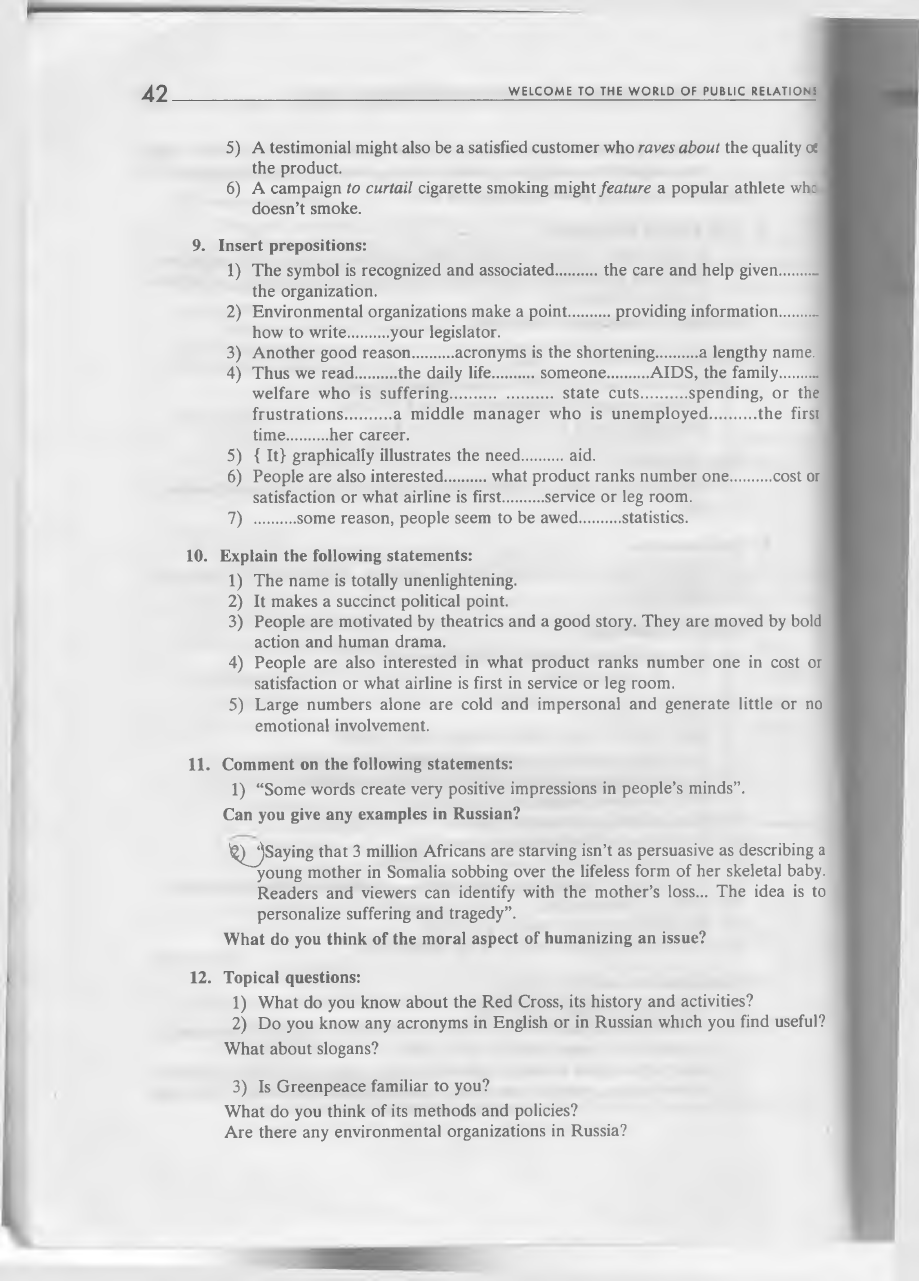ВУЗ: Не указан
Категория: Не указан
Дисциплина: Не указана
Добавлен: 01.04.2021
Просмотров: 1555
Скачиваний: 7

38
W E L C O M E TO THE W O R L D O F PUBLI C R E L A T I O N S
Semantics
The dictionary definition of words may be clear and Concise, but there is another
aimension to words — their connotative meaning to various individuals and groups of
people. fThe meaning given to words and the changes that1 occur in these meanings as
time goes on is the branch of linguistics called
semantics.
To write persuasively and to influence target audiences, you must be sensitive to
semantics. Words trigger images and feelings. Some words create very positive impres
sions in people’s minds. Persuasive messages often contain the following words: discov
ery, ease, guarantee, health, love, money, new, proven, results, safety, save, you.
Suggestions for Action
Persuasive writing must give people unformation on how to take action, and the
suggestion must be feasible.
A campaign by a utility provides a good example. If the company really wants
people to conserve energy, it must provide information on how to do so. The sugges
tions may be as simple as turning the thermostat down to 68 degrees, wearing sweaters
in the house during the winter months, or purchasing a roll of weather stripping to
place around the windows and doors. All these suggestions are within the capability of
the utility’s customers.
^
However, if the suggestion is to insulate your house thoroughly, this may not be
feasible for comsumers with limited incomes. In this case, the utility may accompany
the suggestion with a special program of interest-free loans or a discount coupon to
make it easier for customers to take the recommended action. In this way, the sugges
tion becomes feasible to thousands more homeowners.
Environmental organizations, to use another example, make a point of providing
information on how to write to your legislator. They provide not only the legislstor’s
address but also a sample letter that you can copy. Greenpeace simply mails its mem
bers postcards with preprinted messages. All you have to do is sign the postcard and
affix a stamp.
□ Words and word-combinations
1. semantics — семантика
2. to be sensitive to smth — быть чувствительным, восприимчивым к ч.-л.
3. a feasible suggestion — осуществимое предложение
4. limited incomes — ограниченные доходы
5. interest-free loans — беспроцентные ссуды
6. to take the recommended action — предпринять рекомендованные дей
ствия
7. to provide a sample letter — представить образец письма

" Э С О Б И Е П О А Н Г Л И Й С К О М У Я З Ы К У Д Л Я С Т У Д Е Н Т О В Г У М А Н И Т А Р Н Ы Х В У З О В
39
а
Content and Structure
с ш у ,
C JJJLK K C -
People are motivated by theatrics and a good story. They are moved by bold action
and human drama. Your message should go beyond cold facts or even eloquent phras
es. If you can Vividly describe what you are talking about — if you can paint pictures —
your message will be more persuasive.
A number of techniques can make a message more persuasive; many of them have
already been discussed. Here is a summary of additional writing devices.
Drama.
Everyone likes a good story. This is often accomplished by graphically
illustrating an event or a situatiof^few spapers often dramatize a story to boost reader
interest Thus we read about the daily life of someone with AID^, the family on welfare
who is suffering because of state cuts in spending, or the frustrations of a middle man
ager who is unemployed for the first time in her career. In the newsroom, this is called
humanizing an issue
.
mLf
Dramatizing is also used in public relations. Relief organizations, in particular,
AG№t>G-'
i i*
p e u i
МцОос
к J
.
.
.
attempt to galvanize public concern to attract donations. The idea is to personalize
suffering and tragedy.
Saying that 3 million Africans are starving isn’t as persuasive as describing a young
mother in Somalia sobbing over the lifeless form of her skeletal baby. Readers and
viewers can identify with the m other’s loss, which graphically illustrates the need for
aid. \Large numbers alone are cold and impersonal and generate little or no emotional
involvement.
A more mundane use of dramatizing is the application story, sent to the trade
press. This is sometimes called the
case study technique,
in which a manufacturer pre
pares an article on how an individual or a company is using the product.
Statistics.
For some reason, people seem to be awed by statistics. The use of num
ber, which appear so precise, seems to convey objectivity, largeness, and importance in
a credible way.
Numbers can be effective, but a writer should use them sparingly. A news release
crammed with them tends to overwhelm the reader.
□ Words and word-combinations
1. eloquent — красноречивый
2. writing devices — приемы письма
3. to boost reader interest — повысить интерес читателей
4. a newsroom — отдел новостей
5. to attract donation — привлечь пожертвования
6. to personalize — персонифицировать
7. to generate emotional involvement — вызвать чувство сопричастности

40
W E L C O M E TO THE W O R L D O F PUBLI C R E L A T I O N S
Surveys and Polls
The public and the media express a great deal of interest in what might be called
popularity ratings. During a presidential election campaign, various polls and surveys
about who’s ahead and why seem to dominate coverage. People are also interested in
what product ranks number one in cost or satisfaction or what airline is first in service
or leg room .
The use of a poll or survey is a good device for getting audience attention and for
generating news coverage. However, the writer should report the findings of a survey,
and its limitations, accurately.
Examples
A statement or an opinion is more persuasive if some examples are given. In this
way, generalized statement become clear and more understandable. Examples can clar
ify, elaborate on, and reinforce basic messages.
Testimonials
The testimonial is a form of source credibility that can be either explicit or implied.
A campaign to curtail cigarette smoking might feature a popular athlete who doesn’t
smoke. A testimonial might also be a satisfied customer who raves about the quality of
the product. (Testimonials are usually given by people or organizations not formally
connected with the product, service, or cause.
Endorsements
/5 A variant of the testimonial is the endorsement. Endorsements may be made by
individuals, organizations, or media outlets. Political candidates receive endorsements.
□ Words and word-combinations
1. popularity ratings — рейтинг популярности
2. to dominate coverage — доминировать в средствах массовой информации
3. to elaborate on — детально разрабатывать
4. testimonial — рекомендация
5. endorsement — подтверждение, одобрение
6. leg room — пространство между креслами
EXERCISES
1. Look up the pronunciation of the following words:
crescent, succinct, to occur, thermostat, sweater, thoroughly, career, to
overwhelm, awed
2. Give English equivalents:
бороться за равноправие, содержать в себе ч.-л., беспроцентный займ,*

~ З С О Б И Е П О А Н Г Л И Й С К О М У Я З Ы К У Д Л Я С Т У Д Е Н Т О В Г У М А Н И Т А Р Н Ы Х В У З О В
41
скидка, в рамках возможностей, ограниченные доходы, сохранять энер
гию, выразительная фраза, живо описать, явный, подразумеваемый.
Reproduce them in situations from the text.
3. Give Russian equivalents:
to range from... to, to be concise, to be sensitive to smth, to be on welfare, a
utility, cuts in spending, frustrations, to be awed by smth, sparingly, to elaborate
on smth, to reinforce.
Use them in situations of your own.
4. Translate in writing:
1) You aren’t likely to produce a worldfamous symbol.
2) The first paragraph of the sector S e m a n t i c s .
3) The sector S u g g e s t i o n s f o r A c t i o n .
5. Give synonyms:
ridiculous, the globe, to comprehend, branch, to occur, to attempt, precise, to
sob.
6
. Give antonyms:
pronounceable, memorable, lengthy, sensitive, shortening, loss, objectivity,
importance.
Answer the questions:
1) What are familiar symbols around the globe?
2) What do slogans state?
3) Can acronyms be ridiculous?
4) What is semantics?
5) What words do persuasive messages often contain?
6) What must persuasive writing give people information on?
7) Can all the suggestions be feasible to all the customers?
8) What additional writing devices are there?
9) What is done in newspapers to boost reader interest?
10) In what way is humanizing an issue done?
11) How should numbers be used?
12) What seems to dominate coverage during presidential election campaigns?
13) What can examples do?
14) Who are testimonials usually given by?
15) Is the endorsement a variant of the testimonial?
8
. Paraphrase the italicized words:
1) Words
trigger
images and feelings.
2)
Coined
from the
initial
letters of the name of some organization or
cause,
an
acronym can
in some cases
be
highly
useful.
3) Relief organization attempt
to galvanize public concern
to attract donations.
4) A news release
crammed with
them (numbers)
tends to overwhelm
the reader.

42
W E L C O M E T O T H E W O R L D O F P U B L I C R E L A T I O N :
5) A testimonial might also be a satisfied customer who
raves about
the quality of
the product.
6) A campaign
to curtail
cigarette smoking might
feature
a popular athlete wh :
doesn’t smoke.
9. Insert prepositions:
1) The symbol is recognized and associated......... the care and help given.......... |
the organization.
2) Environmental organizations make a point......... providing information..........
how to write......... your legislator.
3) Another good reason......... acronyms is the shortening..........a lengthy name.
4) Thus we read......... the daily life..........someone...........AIDS, the family.........j
welfare who is suffering........................ state cuts.......... spending, or the
frustrations.......... a middle m anager who is unem ployed...........the firs:
time......... her career.
5) { It} graphically illustrates the need......... aid.
6) People are also interested......... what product ranks number one...........cost or
satisfaction or what airline is first......... service or leg room.
7)
some reason, people seem to be awed......... statistics.
10. Explain the following statements:
1) The name is totally unenlightening.
2) It makes a succinct political point.
3) People are motivated by theatrics and a good story. They are moved by bold
action and human drama.
4) People are also interested in what product ranks number one in cost or
satisfaction or what airline is first in service or leg room.
5) Large numbers alone are cold and impersonal and generate little or no
emotional involvement.
11. Comment on the following statements:
1) “Some words create very positive impressions in people’s minds”.
Can you give any examples in Russian?
^J^ S ay in g that 3 million Africans are starving isn’t as persuasive as describing a
young mother in Somalia sobbing over the lifeless form of her skeletal baby.
Readers and viewers can identify with the m other’s loss... The idea is to
personalize suffering and tragedy”.
What do you think of the moral aspect of humanizing an issue?
12. Topical questions:
1) What do you know about the Red Cross, its history and activities?
2) Do you know any acronyms in English or in Russian which you find useful?
What about slogans?
3) Is Greenpeace familiar to you?
What do you think of its methods and policies?
Are there any environmental organizations in Russia?